Top Rankings
Lake Station Community Schools School District ranks among the top 20% of public school district in Indiana for:
Category
Attribute
Diversity
Most diverse schools (Top 1%)
For the 2025 school year, there are 3 public schools serving 1,144 students in Lake Station Community Schools School District. This district's average testing ranking is 2/10, which is in the bottom 50% of public schools in Indiana.
ÎÛÎÛÂþ» Schools in Lake Station Community Schools School District have an average math proficiency score of 15% (versus the Indiana public school average of 38%), and reading proficiency score of 24% (versus the 41% statewide average).
Minority enrollment is 66% of the student body (majority Hispanic), which is more than the Indiana public school average of 37% (majority Hispanic and Black).
Overview
This School District
This State (IN)
# Schools
3 Schools
1,904 Schools
# Students
1,144 Students
1,029,704 Students
# Teachers
73 Teachers
67,292 Teachers
Student : Teacher Ratio
16:1
16:1
District Rank
Lake Station Community Schools School District, which is ranked within the bottom 50% of all 394 school districts in Indiana (based off of combined math and reading proficiency testing data) for the 2021-2022 school year.
The school district's graduation rate of 90-94% has increased from 85-89% over five school years.
Overall District Rank
#337 out of 400 school districts
(Bottom 50%)
(Bottom 50%)
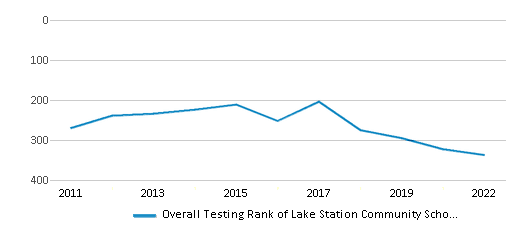
Math Test Scores (% Proficient)
15%
38%
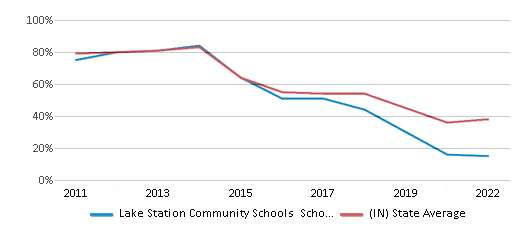
Reading/Language Arts Test Scores (% Proficient)
24%
41%
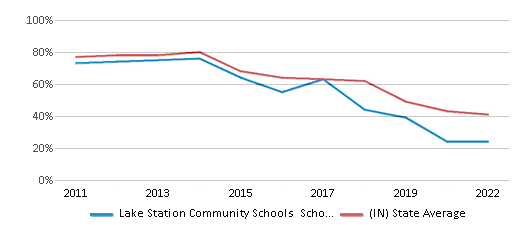
Science Test Scores (% Proficient)
18%
34%
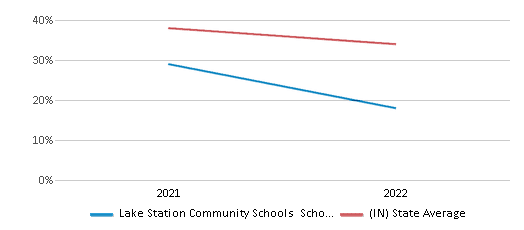
Graduation Rate
90-94%
88%
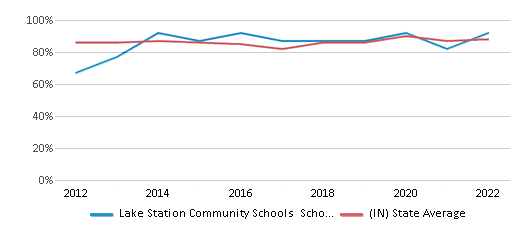
Students by Ethnicity:
Diversity Score
0.67
0.56
# American Indian Students
2 Students
1,659 Students
% American Indian Students
n/a
n/a
# Asian Students
n/a
31,157 Students
% Asian Students
n/a
3%
# Hispanic Students
507 Students
150,723 Students
% Hispanic Students
44%
15%
# Black Students
173 Students
137,666 Students
% Black Students
15%
13%
# White Students
389 Students
650,927 Students
% White Students
34%
63%
# Hawaiian Students
n/a
1,062 Students
% Hawaiian Students
n/a
n/a
# Two or more races Students
73 Students
56,510 Students
% of Two or more races Students
7%
6%
Students by Grade:
# Students in PK Grade:
-
23,535
# Students in K Grade:
95
72,972
# Students in 1st Grade:
85
74,029
# Students in 2nd Grade:
102
76,464
# Students in 3rd Grade:
84
74,925
# Students in 4th Grade:
72
76,116
# Students in 5th Grade:
92
74,259
# Students in 6th Grade:
68
75,803
# Students in 7th Grade:
82
76,624
# Students in 8th Grade:
73
78,109
# Students in 9th Grade:
102
80,782
# Students in 10th Grade:
96
82,616
# Students in 11th Grade:
98
81,109
# Students in 12th Grade:
95
79,955
# Ungraded Students:
-
2,406
District Revenue and Spending
The revenue/student of $13,377 is higher than the state median of $13,222. The school district revenue/student has stayed relatively flat over four school years.
The school district's spending/student of $12,435 is less than the state median of $12,852. The school district spending/student has stayed relatively flat over four school years.
Total Revenue
$15 MM
$13,615 MM
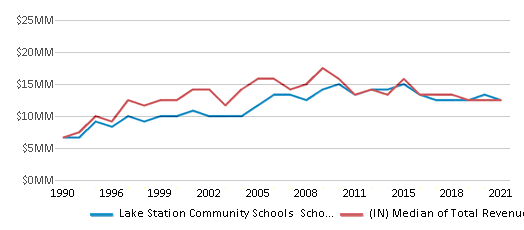
Spending
$14 MM
$13,234 MM
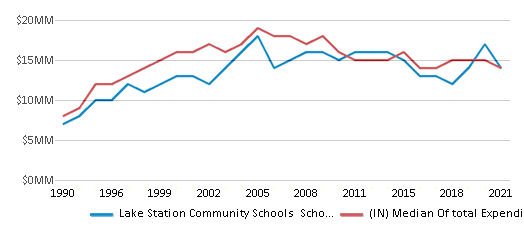
Revenue / Student
$13,377
$13,222
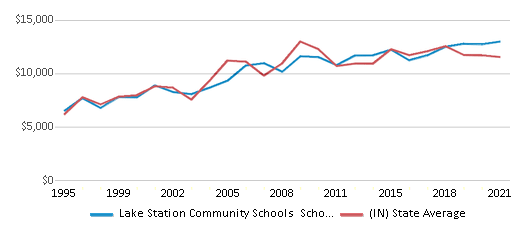
Spending / Student
$12,435
$12,852
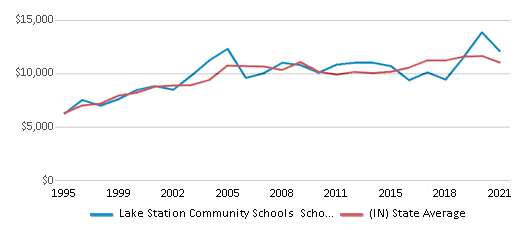
Best Lake Station Community Schools School District ÎÛÎÛÂþ» Schools (2025)
School
(Math and Reading Proficiency)
(Math and Reading Proficiency)
Location
Grades
Students
Rank: #11.
Alexander Hamilton Elementary School
(Math: 30-34% | Reading: 30-34%)
Rank:
Rank:
4/
Bottom 50%10
2900 Lake St
Lake Station, IN 46405
(219) 962-1824
Lake Station, IN 46405
(219) 962-1824
Grades: K-5
| 227 students
Rank: #22.
Virgil I Bailey Elementary School
(Math: 25-29% | Reading: 25-29%)
Rank:
Rank:
3/
Bottom 50%10
2100 Union St
Lake Station, IN 46405
(219) 962-1302
Lake Station, IN 46405
(219) 962-1302
Grades: K-5
| 303 students
Rank: #33.
Thomas A Edison Jr-sr High School
(Math: 5% | Reading: 21%)
Rank:
Rank:
1/
Bottom 50%10
3304 Parkside Ave
Lake Station, IN 46405
(219) 962-8531
Lake Station, IN 46405
(219) 962-8531
Grades: 6-12
| 614 students
Frequently Asked Questions
How many schools belong to Lake Station Community Schools School District?
Lake Station Community Schools School District manages 3 public schools serving 1,144 students.
What is the rank of Lake Station Community Schools School District?
Lake Station Community Schools School District is ranked #336 out of 394 school districts in Indiana (bottom 50%) based off of combined math and reading proficiency testing data for the 2021-2022 school year. This district ranks in the top 20% of Indiana school districts for: Most diverse schools (Top 1%)
What is the racial composition of students in Lake Station Community Schools School District?
44% of Lake Station Community Schools School District students are Hispanic, 34% of students are White, 15% of students are Black, and 7% of students are Two or more races.
What is the student/teacher ratio of Lake Station Community Schools School District?
Lake Station Community Schools School District has a student/teacher ratio of 16:1, which is higher than the Indiana state average of 15:1.
What is Lake Station Community Schools School District's spending/student ratio?
The school district's spending/student of $12,435 is less than the state median of $12,852. The school district spending/student has stayed relatively flat over four school years.
Recent Articles

Year-Round Or Traditional Schedule?
Which is more appropriate for your child? A year-round attendance schedule or traditional schedule? We look at the pros and cons.

Why You Should Encourage Your Child to Join a Sports Team
Participating in team sports has a great many benefits for children, there is no doubt. In this article you will learn what those benefits are.

White Students are Now the Minority in U.S. ÎÛÎÛÂþ» Schools
Increasing birth rates among immigrant families from Asia and Central and South America, combined with lower birth rates among white families, means that for the first time in history, public school students in the United States are majority-minority. This shift in demographics poses difficulties for schools as they work to accommodate children of varying language abilities and socio-economic backgrounds.





